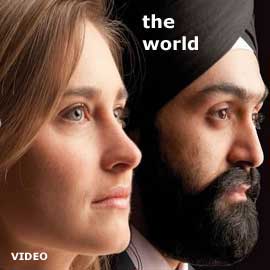Columnists
Saragarhi Redux:
Janam Da Firangee,
Sikhi Mai Mangee
FATEHPAL SINGH TARNEY
People who have been blessed with having been born into the Sikh faith often forget that without converts there would be no Sikh religion.
I, for example, have something very significant in common with our first four Gurus that most Sikhs do not have. I did not have Sikh parents, but neither did Baba Nanak, Guru Angad, Guru Amardas, nor Guru Ramdas.
I do not see myself as being on the same level as our Gurus in any manner whatsoever but, in a way, I am in very good company with them in terms of “parentage.”
Every September, on or around September 12, whether I'm here in Florida or in Michigan at my summer home, I try to make a short presentation to the Saadh Sangat commemorating the Battle of Saragarhi which was waged in 1897. To be sure, ceremonies regarding the tragic events of September 11, 2001 overshadow this observance, which is quite understandable. Thus, on Sunday, September 11, 2016, we shall commemorate the 15th anniversary of 9/11. The following day, we Sikhs and hopefully others will remember Saragarhi.
Of course, battles waged earlier in Sikh history, such as those fought during the time of our Tenth Master, also serve as inspiration for modern Sikhs in peace and in war, such as The 1704 Battle of Chamkaur and the battle in 1764 defending the Darbar Sahib in Amritsar where 30 Singhs tackled 30,000 Afghans.
There are other great battles as well, but Saragarhi was particularly unusual.
The Battle of Saragarhi was fought over a very short time frame -- about 6 hours -- at a remote outpost of the British Raj in what is now the North West Frontier Province of Pakistan [its new name is Khyber Pakhtunkhwa, abbreviated as “KP“].
21 members of the 36th Sikh Regiment (now the 4th Sikh Regiment), held out against an attack of a large force of Afridi Pathan tribesmen -- perhaps over 10,000 fighters. Reinforcements could not get there in time. There were no commissioned officers at this post. The commander was a sergeant, a havaldar, which was my rank in the American military, which is one reason I can personally relate to this battle.
Havaldar Ishar Singh had told his 20 subordinates that they had three options: 1) retreat and abandon their post. 2) surrender to the attackers and hope for mercy, or 3) fight to the death. In the grand tradition of the Sant-Sipahi, they chose the latter.
All 21 Sikhs died fighting, but when a relief column finally arrived, there were over 600 dead Pathans at or near the outpost. Lest we forget, two of the Sikhs at Saragarhi were non-combatant cooks!
All 21 Sikhs received the Order of Merit, which was equivalent to the Victoria Cross in England and the Param Vir Chakra in India.
I remember reading a comment by a reader here on sikhchic.com on an article on General Harbakhsh Singh about a relative of his who was captain of a ship in the Merchant Navy. Once, when the ship arrived at a seaport in Pakistan, this ship captain was on the dock when a Pakistani man approached him saying that he was a veteran of the Pakistani military who fought against the India in the 1965 war. I gather what he said was that the Pakistanis held their own against the Indian Army until the Sikh units arrived and routed the Pakistanis by fighting like ‘lohaa’ – iron!
There is a Sardar who was raised in the NWFP near Peshawar. He conveys three interesting things about the Pathans there: a) they are proud of how they have fought the Americans, b) and of how they have fought the Punjabi-dominated Pakistani military, and c) they still respect the military prowess of the Sikhs!
The military exploits of the Sikhs have had a tremendous impact on non-Sikhs as well as Sikhs. One big reason for this is we fight for the rights of others -- those who are weak, voiceless and oppressed -- at great personal peril and even against great odds.
Some time ago, I went into a donut shop. In south Florida it is very likely that one will encounter an employee from any of the countries on the subcontinent in such a place. The person who served me was a young musalmani (Muslim woman) in a hijab. I greeted her with “As-salamu alaykum,” and she responded, "Wa-Alaikum-Salaam."
She then pointed her finger at me and said, “I know you people. I'm from Bangladesh and you people are our friends. You helped us get our independence from Pakistan!”
Because the store was not busy we chatted briefly. Here was a young lady, a college student, born long after the 1971 war between India and Pakistan, who knew the names of two Sardar generals – not only General Aurora, but also General Shabeg Singh (later the hero of the 1984 Battle of Amritsar).
Obviously, not all young Bangladeshis know what she knows, but how many young Sikhs know the names of these great generals?
The signal post at Saragarhi was not important in and of itself, but was significant because 21 Sikhs chose to defend it! The defense of Saragarhi and the 21 brave Sardars who did their duty and died at their posts over a century ago should never be forgotten. Saragarhi should inspire us not only in times of war but also in everyday life.
I used to think that the qualities that I thought Sikh soldiers always had which gave them courage and effectiveness (himmat) on the battlefield were: 1) patriotism, 2) intellect and intelligence, 3) training, and 4) physical fitness.
A dear young friend, Amrinder Singh, from my Florida sangat reminded me that the ultimate and highest source of Sikh military courage and success is Gurbani.
August 31, 2016
Conversation about this article
1: Gurjender Singh (Maryland, USA ), September 01, 2016, 3:57 PM.
A year ago there was news that there will be a film on the Battle of Saragarhi. Any word on the date of its release?
2: Ravin Kaur (Faridabad, India), September 01, 2016, 7:24 PM.
As always, your articles are awesome. We salute your wisdom and creativity. You are right, the ultimate and highest source of Sikh military courage and success is Gurbani.
3: Sangat Singh (Kuala Lumpur, Malaysia), September 03, 2016, 5:16 PM.
All the 21 Sikh non-commissioned officers and soldiers of other ranks who laid down their lives in the Battle of Saragarhi were posthumously awarded the Indian Order of Merit, the highest gallantry award of that time which an Indian soldier could receive by the hands of the British crown, the corresponding gallantry award being Victoria Cross. This award is equivalent to today's Param Vir Chakra awarded by the President of India. They were all born in the Majha region of Punjab.
4: Gurtej Singh (Chandigarh, Punjab), September 03, 2016, 10:04 PM.
It is a wonderful narration. It is precise - not an extra word. The depth of feeling cannot be missed. It was a an extraordinary event. Soldiering is an activity of the upright and the compassionate. You may consider adding the last message of the signalman before he packed up his gear. It shows great composure in the face of certain death ... the standing ovation in the British Parliament in honour of the braves ... the gurdwaras that have been constructed in their memory.
5: EDITOR, sikhchic.com (Mount Forest, Ontario, Canada), September 06, 2016, 11:31 AM.
The film is scheduled to be released in 2017.



